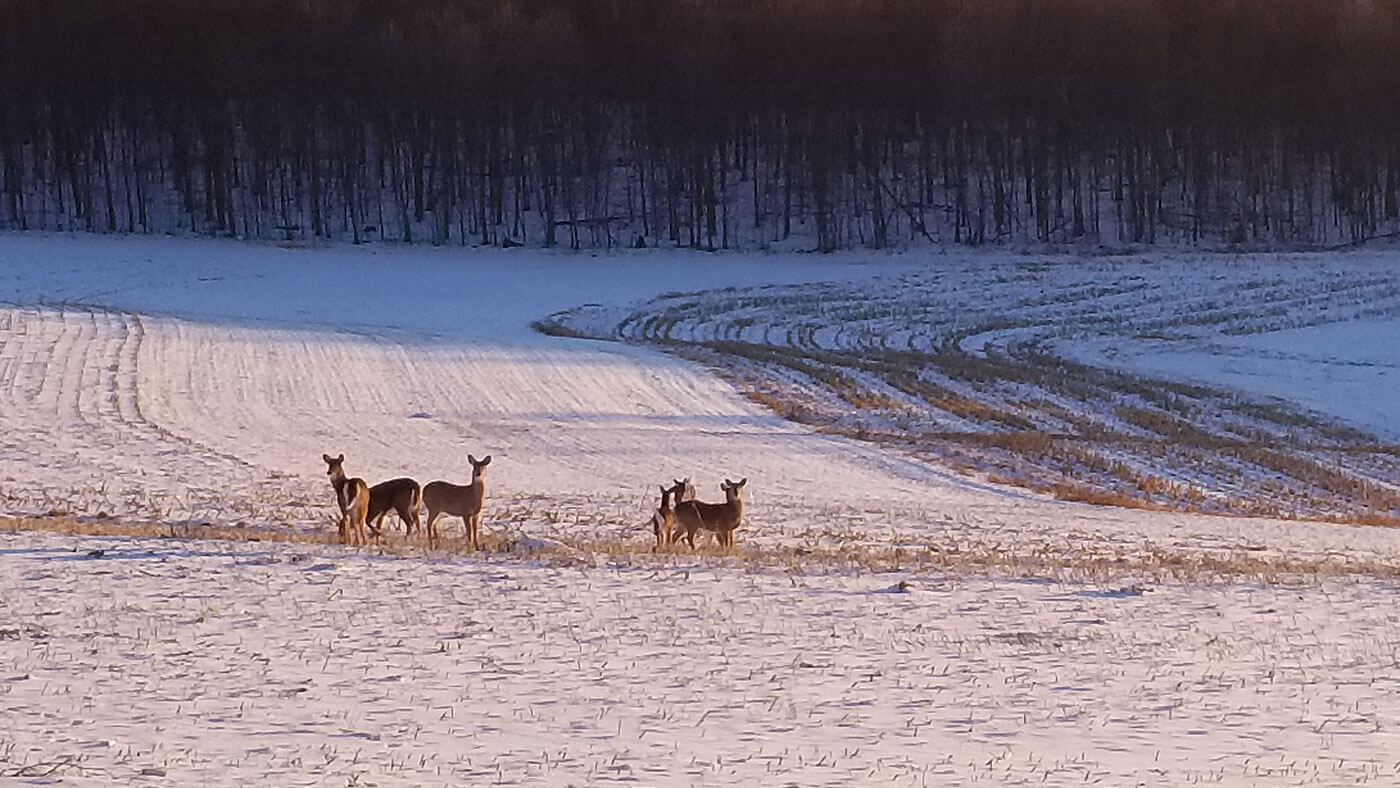- Savage Blog
- CWD and Deer Overpopulation Issues
CWD and Deer Overpopulation Issues

This is the second of three articles in which Doug Duren shares information about Chronic Wasting Disease (CWD) along with his experience and perspective as a landowner and hunter in Southwest Wisconsin’s CWD endemic area.
Read the first article: What is CWD and What Can Be Done About It?
“When someone talks about deer being over-populated, I ask: from who’s perspective?” So wondered Steven Rinella on Episode 11 of The Meateater Podcast, recorded in the Spring of 2015 on our family farm near Cazenovia, Wisconsin. I was Rinella’s podcast guest and with Janis Putelis joining us, we had a wide-ranging conversation about deer management. Subjects included hunters wanting to see plenty of deer, oak management, agricultural losses, car/deer accidents, growing and hunting big bucks, native species, and deer degrading wildlife habitat. Absent from the conversation was Chronic Wasting Disease (CWD) and how population and deer demographics influence CWD spread and prevalence. In the years since, CWD has become a bigger part of the deer hunting conversation and according to Theodore Roosevelt Conservation Partnership, “the biggest threat to the future of deer hunting”.
Small Farm Sensibility, Animal Husbandry, Deer and CWD
I grew up and worked in small farm animal production, most recently grass-fed cattle, for much of my life. As a result, I have experience with animal husbandry: the day-to-day observation and feeding of a herd, preventative care and what to do when animals get sick. It takes time, observation, common sense and knowing when it’s time to call an expert, the veterinarian. Some of what I’ve learned also applies to deer population and disease management.
Deer are plentiful in the farm country where I live in Wisconsin’s Driftless Area. I enjoy observing them and their behavior and I’m an avid deer hunter. I’ve been interested in deer management for decades and am active in the citizen conservation input opportunities our state provides. I’m a member of our County Deer Advisory Committee and Conservation Congress. When Chronic Wasting Disease was first discovered in Southwest Wisconsin in 2002, I listened to the wildlife biologists and learned what I could about the disease. I also thought about the disease and how to handle it from my small farmer/animal husbandry perspective. After all, white-tailed deer are more plentiful than cattle in our area.
We thought we were killing a good number of deer on our property during the early 2000s. We tried to keep numbers in balance with the habitat, shooting many more does than bucks and passing on some younger bucks and allowing them to get to older age classes. Our farm has been in the CWD management zone since 2003 and we get all our deer tested. By 2016 none had tested positive. Earn a Buck, a highly effective deer population management technique that was used on and off by Wisconsin DNR since 1996, was terminated by Wisconsin lawmakers in 2011. As a result, deer numbers increased quickly in Southwest Wisconsin’s CWD endemic area. Along with population growth in the area, CWD spread quickly, and prevalence expanded dramatically. In 2017, the disease was discovered on our farm: two younger bucks tested positive for CWD. The number of deer testing positive has increased quickly since. During the 2021 and 2022 seasons, 60% of the 18 bucks we harvested tested positive. Adult does are testing positive at a much lower rate, but that percentage has also increased to 15%.
These Deer Population Estimate graphs below, published by Wisconsin DNR, show population increases in two counties in the CWD endemic area is Southwest Wisconsin. The red line denotes 2011, the year Wisconsin lawmakers terminated Earn a Buck and ended effective deer population management in Wisconsin.


These CWD Prevalence Trend graphs below, published by Wisconsin DNR, show prevalence growth trends in the study zone in the southern parts of Richland and Sauk Counties, and are similar to our anecdotal experience 20 miles north. The red line again denotes 2011, the year Wisconsin lawmakers terminated Earn a Buck as a deer management tool.


Does Population affect CWD Prevalence and Spread?
CWD is a transmissible disease, meaning it is most commonly spread animal to animal, but it may be contracted in other ways, like through environmental exposure, including bait piles and mineral licks. CWD is always fatal and a deer can have the disease for about two years before showing clinical signs and eventually dying. During that time, it is also casting off the disease to other deer and into the environment.
Beyond understanding that CWD spreads from animal-to-animal contact, there have been studies and discussion about the modes of transmission, or how CWD spreads within the herd. That discussion centers around Frequency Dependent and Density Dependent transmission. That is, does the disease spread because of deer behavior and habits (Frequency) or if higher populations of deer in an area cause the disease to spread more quickly (Density Dependence)? From a scientific study, but also a common sense, animal husbandry, deer behavior/hunter perspective, it’s both.
Frequency Dependent Transmission
Deer are social animals, with does forming family groups and they tend to have a smaller home range. Does and other antlerless deer (fawns in their first year) usually outnumber adult (antlered) bucks by large margins, especially in high population areas. If a doe contracts CWD, there is a high probability she will pass it on to deer they are in close and frequent contact with, especially members of their family group. Additionally, studies have shown that a CWD positive doe can pass the disease on to their fawn in utero. And, since the first thing a doe does to a newborn fawn is lick it clean and with that grooming behavior continuing as the fawn grows, there are multiple ways the disease can be transferred.
Here's an article from Deer and Deer hunting magazine about the subject.
If a fawn is CWD positive and even though the always fatal disease takes about 24 months before the deer dies, think about what high prevalence will do to age structure in a herd. The herd age will trend younger.
Bucks are also very social and during the spring and summer often live in bachelor groups and exhibit shared grooming behaviors within that group. Young bucks tend to travel far in search of new territory and when fall comes and the rut begins, bucks travel and visit does in a wider area.
So, deer behavior by all members of the herd supports the idea of frequency dependent transmission.
Density Dependent Transmission
Imagine being at a crowded event, like an indoor concert or at a bar, where people are in close proximity to one another. If a communicable disease is being carried by people in that crowd, it’s pretty easy to see how it could spread more quickly than if people are spread out. That, in a nutshell is the basis of density dependent transmission. With deer, it is just common sense that if disease is present in an area of higher population it makes it easier for the disease to spread.
Add deer behavior and high population together and you have a recipe for faster spread and increasing prevalence. Look at the maps and graphs included with this article. It’s pretty clear the data and the anecdotal evidence support those ideas.
Other Issues caused by Deer Overpopulation
Overpopulation of white-tailed deer in areas of the eastern United States is a growing issue. In many areas hunters have not harvested the surplus of deer each year. Thus, populations have grown beyond what makes sense. The detrimental effects of overpopulation on native plant species and wildlife habitat are well documented. In some areas deer are destroying the habitat they and other species rely on. Additionally, several states have implemented Wildlife Damage Abatement and Claims Programs that pay farmers for damage deer do to their crops. The National Deer Association discusses overpopulation issues in this article.

The map above, provided by the National Deer Association shows deer densities in 2008. A square mile is 640 acres. Green areas hold less than 15 deer per square mile, yellow 15-30, orange 30 to 40 and red areas have more than 45 deer per square mile.

The map above, provided by the USGS Wildlife Health Center, shows the distribution of CWD in North America. The areas with the largest populations of white-tailed deer are also the centers of CWD, especially in the eastern United States.
Overlay the two graphics above from NDA and USGS and it’s easy to see that there is a relationship between high populations and the growth of CWD, especially east of the Rocky Mountains.
Conclusion
In conclusion, yes, there can be too many deer. Overpopulation causes damage to the ecosystem, has a negative effect on deer habitat and the habitat of other members of the biotic community. Overpopulation of deer also increases the speed at which Chronic Wasting Disease spreads across the landscape and grows in prevalence in the herd. There are places in the country where that is causing the age of the herd to trend younger and even for numbers to start to collapse. Population reduction, in some cases dramatic reduction, may be able to change the trajectory of CWD on the landscape. If we don’t do more to control deer population and disease, CWD will do it for us.
So, keep hunting deer! Listen to the experts and your state deer biologists. Take an extra deer and give the venison to someone who will use it. Many states have venison donation programs. Landowners, welcome hunters who are interested in herd population control. The future of deer and deer hunting depends on us!


